Deck 36: Appendix: Aggregate Expenditure and the Multiplier
Question
Question
Question
Question
Question
Question
Question
Question
Question
Question
Question
Question
Question
Question
Question
Question
Question
Question
Question
Question
Question
Question
Question
Question
Question
Question
Question
Question
Question
Question
Question
Question
Question
Question
Question
Question
Question
Question
Question
Question
Question
Question
Question
Question
Question
Question
Question
Question
Question
Question
Question
Question
Question
Question
Question
Question
Question
Question
Question
Question
Question
Question
Question
Question
Question
Question
Question
Question
Question
Question
Question
Question
Question
Question
Question
Question
Question
Question

Unlock Deck
Sign up to unlock the cards in this deck!
Unlock Deck
Unlock Deck
1/78
Play
Full screen (f)
Deck 36: Appendix: Aggregate Expenditure and the Multiplier
1
The Great Depression changed economic thought by:
A)regulating the foreign exchange market, the bond market, and the government.
B)eliminating the stock market, the labor market, and the bond market.
C)creating banks, the goods market, and the labor market.
D)challenging the notion of a self-correcting economy.
A)regulating the foreign exchange market, the bond market, and the government.
B)eliminating the stock market, the labor market, and the bond market.
C)creating banks, the goods market, and the labor market.
D)challenging the notion of a self-correcting economy.
challenging the notion of a self-correcting economy.
2
Aggregate expenditure is the sum of:
A)consumption, planned investment, imports, and taxes.
B)consumption, exports, and planned investment.
C)planned Investment, government expenditure, exports, and imports.
D)consumption, planned investment, government expenditure, and net exports.
A)consumption, planned investment, imports, and taxes.
B)consumption, exports, and planned investment.
C)planned Investment, government expenditure, exports, and imports.
D)consumption, planned investment, government expenditure, and net exports.
consumption, planned investment, government expenditure, and net exports.
3
Consumption refers to the:
A)purchases of goods and services by households.
B)taxes collected by the government.
C)sum of all purchases of goods and services in the economy.
D)total purchases of goods and services by consumers and the government.
A)purchases of goods and services by households.
B)taxes collected by the government.
C)sum of all purchases of goods and services in the economy.
D)total purchases of goods and services by consumers and the government.
purchases of goods and services by households.
4
Planned investment refers to the:
A)total investment.
B)intentional expenditures by companies on capital goods such as factories, machinery, and software.
C)total purchases of inputs by companies.
D)spending on capital imports by an economy.
A)total investment.
B)intentional expenditures by companies on capital goods such as factories, machinery, and software.
C)total purchases of inputs by companies.
D)spending on capital imports by an economy.

Unlock Deck
Unlock for access to all 78 flashcards in this deck.
Unlock Deck
k this deck
5
The difference between total investment and planned investment is that:
A)planned investment is total investment minus taxes.
B)planned investment is always larger than total investment.
C)total investment includes changes in inventories.
D)planned investment includes changes in inventories.
A)planned investment is total investment minus taxes.
B)planned investment is always larger than total investment.
C)total investment includes changes in inventories.
D)planned investment includes changes in inventories.

Unlock Deck
Unlock for access to all 78 flashcards in this deck.
Unlock Deck
k this deck
6
The relationship between consumption and income is:
A)sometimes positive and sometimes negative.
B)positive.
C)negative.
D)zero.
A)sometimes positive and sometimes negative.
B)positive.
C)negative.
D)zero.

Unlock Deck
Unlock for access to all 78 flashcards in this deck.
Unlock Deck
k this deck
7
The slope of the consumption function is:
A)always 1.
B)positive.
C)negative.
D)zero.
A)always 1.
B)positive.
C)negative.
D)zero.

Unlock Deck
Unlock for access to all 78 flashcards in this deck.
Unlock Deck
k this deck
8
Which of the following figures shows the correct typical shape of the consumption function? 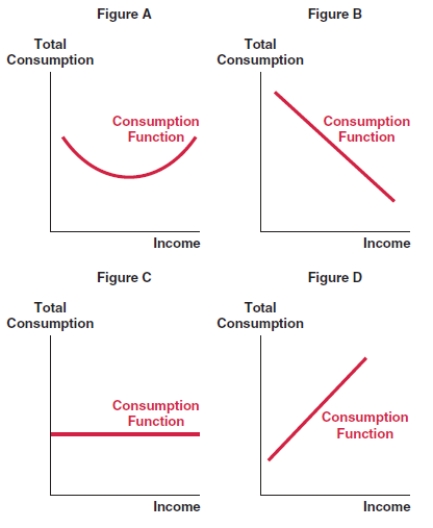
A)Figure A
B)Figure B
C)Figure C
D)Figure D

A)Figure A
B)Figure B
C)Figure C
D)Figure D

Unlock Deck
Unlock for access to all 78 flashcards in this deck.
Unlock Deck
k this deck
9
The consumption function is:
A)the relationship between aggregate expenditure and real GDP.
B)a plot of consumption relative to income taxes in the economy.
C)always negative in slope.
D)a plot of consumption at each level of real GDP.
A)the relationship between aggregate expenditure and real GDP.
B)a plot of consumption relative to income taxes in the economy.
C)always negative in slope.
D)a plot of consumption at each level of real GDP.

Unlock Deck
Unlock for access to all 78 flashcards in this deck.
Unlock Deck
k this deck
10
A movement along the same aggregate expenditure line is caused by a change in:
A)prices.
B)income.
C)price expectations.
D)interest rates.
A)prices.
B)income.
C)price expectations.
D)interest rates.

Unlock Deck
Unlock for access to all 78 flashcards in this deck.
Unlock Deck
k this deck
11
Consumption is $3,500 when income is $4,000, and consumption rises to $5,000 when income is $6,000. What is the marginal propensity to consume?
A)0.75
B)0.5
C)1.33
D)0.25
A)0.75
B)0.5
C)1.33
D)0.25

Unlock Deck
Unlock for access to all 78 flashcards in this deck.
Unlock Deck
k this deck
12
Consumption is $3,600 when income is $4,000, and consumption rises to $4,400 when income is $5,000. What is the marginal propensity to consume?
A)0.9
B)0.2
C)0.8
D)0.5
A)0.9
B)0.2
C)0.8
D)0.5

Unlock Deck
Unlock for access to all 78 flashcards in this deck.
Unlock Deck
k this deck
13
Consumption is $5,900 when income is $6,000, and consumption rises to $6,800 when income is $7,000. What is the marginal propensity to consume?
A)0.9
B)0.1
C)1.11
D)0.2
A)0.9
B)0.1
C)1.11
D)0.2

Unlock Deck
Unlock for access to all 78 flashcards in this deck.
Unlock Deck
k this deck
14
The marginal propensity to consume (MPC) is the:
A)tendency that consumers have to spend more than they save.
B)total consumption as a percentage of real GDP in a country.
C)fraction of each dollar of extra income that households save.
D)fraction of each dollar of extra income that households spend on consumption.
A)tendency that consumers have to spend more than they save.
B)total consumption as a percentage of real GDP in a country.
C)fraction of each dollar of extra income that households save.
D)fraction of each dollar of extra income that households spend on consumption.

Unlock Deck
Unlock for access to all 78 flashcards in this deck.
Unlock Deck
k this deck
15
The slope of the aggregate expenditure line is the:
A)marginal propensity to consume (MPC).
B)fraction of each dollar of extra income that households save.
C)change in income divided by the change in consumption.
D)total consumption in the country as a percentage of real GDP.
A)marginal propensity to consume (MPC).
B)fraction of each dollar of extra income that households save.
C)change in income divided by the change in consumption.
D)total consumption in the country as a percentage of real GDP.

Unlock Deck
Unlock for access to all 78 flashcards in this deck.
Unlock Deck
k this deck
16
Consider the following data. What is the equilibrium GDP in this economy (in billions of dollars)?
A)95
B)90
C)80
D)40
A)95
B)90
C)80
D)40

Unlock Deck
Unlock for access to all 78 flashcards in this deck.
Unlock Deck
k this deck
17
Consider the following data. What is the equilibrium GDP (in trillions of dollars)?
A)7.3
B)8
C)8.7
D)7
A)7.3
B)8
C)8.7
D)7

Unlock Deck
Unlock for access to all 78 flashcards in this deck.
Unlock Deck
k this deck
18
Consider the following data. What is the marginal propensity to consume?
A)0.8
B)0.7
C)0.9
D)0.3
A)0.8
B)0.7
C)0.9
D)0.3

Unlock Deck
Unlock for access to all 78 flashcards in this deck.
Unlock Deck
k this deck
19
Consider the following data. What is the equilibrium GDP in this economy (in millions of $)?
A)3,700
B)3,100
C)2,500
D)4,300
A)3,700
B)3,100
C)2,500
D)4,300

Unlock Deck
Unlock for access to all 78 flashcards in this deck.
Unlock Deck
k this deck
20
Consider the following data. What is the marginal propensity to consume in this economy?
A)0.87
B)1.5
C)0.5
D)0.67
A)0.87
B)1.5
C)0.5
D)0.67

Unlock Deck
Unlock for access to all 78 flashcards in this deck.
Unlock Deck
k this deck
21
Consider the following data. What is the equilibrium GDP in this economy (in millions of dollars)?
A)2,400
B)3,600
C)4,200
D)4,600
A)2,400
B)3,600
C)4,200
D)4,600

Unlock Deck
Unlock for access to all 78 flashcards in this deck.
Unlock Deck
k this deck
22
Consider the following data. Based on this data, over what range of real GDP (in millions of dollars) will businesses need to sell inventory in order to meet current demand?
A)when real GDP is less than 3,600
B)when real GDP is less than 4,200
C)when real GDP is greater than 4,800
D)when real GDP is greater than 4,200
A)when real GDP is less than 3,600
B)when real GDP is less than 4,200
C)when real GDP is greater than 4,800
D)when real GDP is greater than 4,200

Unlock Deck
Unlock for access to all 78 flashcards in this deck.
Unlock Deck
k this deck
23
Consider the following data. Based on this data, over what range of real GDP (in millions of dollars) will businesses build up inventory?
A)when real GDP is less than 3,600
B)when real GDP is less than 4,200
C)when real GDP is greater than 4,800
D)when real GDP is greater than 4,200
A)when real GDP is less than 3,600
B)when real GDP is less than 4,200
C)when real GDP is greater than 4,800
D)when real GDP is greater than 4,200

Unlock Deck
Unlock for access to all 78 flashcards in this deck.
Unlock Deck
k this deck
24
Consider the following data. Based on this data, over what range of real GDP will businesses need to sell inventory in order to meet current demand?
A)when real GDP is equal to potential GDP
B)when real GDP is equal to 9,600
C)when real GDP is greater than 8,400
D)when real GDP is less than 8,400
A)when real GDP is equal to potential GDP
B)when real GDP is equal to 9,600
C)when real GDP is greater than 8,400
D)when real GDP is less than 8,400

Unlock Deck
Unlock for access to all 78 flashcards in this deck.
Unlock Deck
k this deck
25
Consider the following data. Based on this data, businesses will build up inventory when real GDP is:
A)less than 8,400
B)equal to 9,600
C)greater than 8,400
D)greater than 7,200
A)less than 8,400
B)equal to 9,600
C)greater than 8,400
D)greater than 7,200

Unlock Deck
Unlock for access to all 78 flashcards in this deck.
Unlock Deck
k this deck
26
In the Keynesian cross, the 45-degree line:
A)is always lower than the aggregate expenditure function.
B)has the same slope as the aggregate expenditure function.
C)is a plot of all equilibrium GDP levels.
D)is always higher than the aggregate expenditure function.
A)is always lower than the aggregate expenditure function.
B)has the same slope as the aggregate expenditure function.
C)is a plot of all equilibrium GDP levels.
D)is always higher than the aggregate expenditure function.

Unlock Deck
Unlock for access to all 78 flashcards in this deck.
Unlock Deck
k this deck
27
In the Keynesian cross, macroeconomic equilibrium occurs where:
A)real GDP is below the aggregate expenditure line.
B)potential GDP meets the 45-degree line.
C)aggregate expenditure line meets the 45-degree line.
D)aggregate expenditure line is below the 45-degree line.
A)real GDP is below the aggregate expenditure line.
B)potential GDP meets the 45-degree line.
C)aggregate expenditure line meets the 45-degree line.
D)aggregate expenditure line is below the 45-degree line.

Unlock Deck
Unlock for access to all 78 flashcards in this deck.
Unlock Deck
k this deck
28
Consider the Keynesian cross shown here. At the real GDP level of $31 billion, aggregate expenditures are: 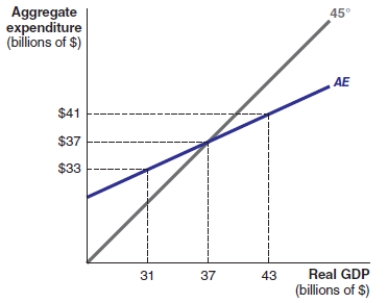
A)$37 billion.
B)$33 billion.
C)$41 billion.
D)$43 billion.

A)$37 billion.
B)$33 billion.
C)$41 billion.
D)$43 billion.

Unlock Deck
Unlock for access to all 78 flashcards in this deck.
Unlock Deck
k this deck
29
Consider the Keynesian cross shown here. At the real GDP level of $43 billion, aggregate expenditures are: 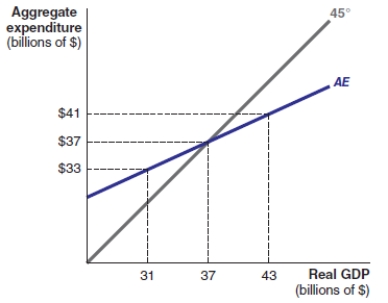
A)$41 billion.
B)$33 billion.
C)$37 billion.
D)$43 billion.

A)$41 billion.
B)$33 billion.
C)$37 billion.
D)$43 billion.

Unlock Deck
Unlock for access to all 78 flashcards in this deck.
Unlock Deck
k this deck
30
Consider the Keynesian cross shown here. What is the slope of the aggregate expenditure function? 
A)0.9
B)0.76
C)0.75
D)0.67

A)0.9
B)0.76
C)0.75
D)0.67

Unlock Deck
Unlock for access to all 78 flashcards in this deck.
Unlock Deck
k this deck
31
Consider the Keynesian cross shown here. The level of equilibrium GDP is: 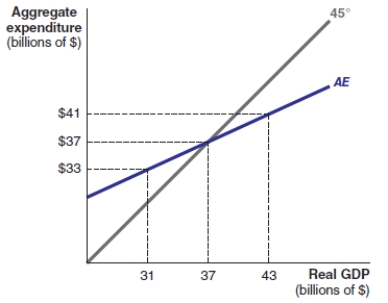
A)$41 billion.
B)$33 billion.
C)$37 billion.
D)$43 billion.

A)$41 billion.
B)$33 billion.
C)$37 billion.
D)$43 billion.

Unlock Deck
Unlock for access to all 78 flashcards in this deck.
Unlock Deck
k this deck
32
Consumption is $53 billion, investment is $47.8 billion, government expenditure is $35.5 billion, and the economy has a trade deficit of $19.2 billion. What is aggregate expenditure?
A)$155.5 billion
B)$120 billion
C)$117.1 billion
D)$136.3 billion
A)$155.5 billion
B)$120 billion
C)$117.1 billion
D)$136.3 billion

Unlock Deck
Unlock for access to all 78 flashcards in this deck.
Unlock Deck
k this deck
33
Consumption is $60 billion, investment is $54 billion, government expenditure is $47 billion, exports are $34 billion, and imports are $41 billion. What is aggregate expenditure?
A)$195 billion
B)$154 billion
C)$161 billion
D)$168 billion
A)$195 billion
B)$154 billion
C)$161 billion
D)$168 billion

Unlock Deck
Unlock for access to all 78 flashcards in this deck.
Unlock Deck
k this deck
34
Consumption is $60 billion, investment is $54 billion, government expenditure is $47 billion, exports are $34 billion, and imports are $41 billion. What is real GDP if the economy is at macroeconomic equilibrium?
A)$161 billion
B)$195 billion
C)$168 billion
D)$154 billion
A)$161 billion
B)$195 billion
C)$168 billion
D)$154 billion

Unlock Deck
Unlock for access to all 78 flashcards in this deck.
Unlock Deck
k this deck
35
Consumption is $51 billion, investment is $54 billion, government expenditure is $46 billion, and the economy has a trade surplus of $8 billion. What is aggregate expenditure?
A)$159 billion
B)$151 billion
C)$143 billion
D)$150 billion
A)$159 billion
B)$151 billion
C)$143 billion
D)$150 billion

Unlock Deck
Unlock for access to all 78 flashcards in this deck.
Unlock Deck
k this deck
36
If consumption decreases:
A)a depression occurs in the economy.
B)real GDP rises.
C)the aggregate expenditure line shifts down.
D)the aggregate expenditure line shifts up.
A)a depression occurs in the economy.
B)real GDP rises.
C)the aggregate expenditure line shifts down.
D)the aggregate expenditure line shifts up.

Unlock Deck
Unlock for access to all 78 flashcards in this deck.
Unlock Deck
k this deck
37
If investment increases:
A)consumption also increases.
B)real GDP falls.
C)the aggregate expenditure line shifts up.
D)the aggregate expenditure line shifts down.
A)consumption also increases.
B)real GDP falls.
C)the aggregate expenditure line shifts up.
D)the aggregate expenditure line shifts down.

Unlock Deck
Unlock for access to all 78 flashcards in this deck.
Unlock Deck
k this deck
38
If investment decreases:
A)the aggregate expenditure line shifts down.
B)real GDP is not affected.
C)government expenditure also decreases.
D)the aggregate expenditure line shifts up.
A)the aggregate expenditure line shifts down.
B)real GDP is not affected.
C)government expenditure also decreases.
D)the aggregate expenditure line shifts up.

Unlock Deck
Unlock for access to all 78 flashcards in this deck.
Unlock Deck
k this deck
39
If exports rise and imports fall:
A)equilibrium GDP falls.
B)aggregate expenditure rises.
C)aggregate expenditure falls.
D)net exports are not affected.
A)equilibrium GDP falls.
B)aggregate expenditure rises.
C)aggregate expenditure falls.
D)net exports are not affected.

Unlock Deck
Unlock for access to all 78 flashcards in this deck.
Unlock Deck
k this deck
40
Aggregate expenditure will shift upward if:
A)consumption or investment or government expenditure or net exports rise.
B)consumption or investment or government expenditure or net exports fall.
C)the government reduces its expenditure and increases its tax collection.
D)the marginal propensity to consume falls.
A)consumption or investment or government expenditure or net exports rise.
B)consumption or investment or government expenditure or net exports fall.
C)the government reduces its expenditure and increases its tax collection.
D)the marginal propensity to consume falls.

Unlock Deck
Unlock for access to all 78 flashcards in this deck.
Unlock Deck
k this deck
41
A rise in the marginal propensity to consume will:
(i) lower the slope of the consumption function.
(ii) increase the slope of the consumption function.
(iii) increase the level of equilibrium GDP.
(iv) shift the aggregate expenditure function upward.
A)(i) and (ii)
B)(ii) and (iii)
C)(i) and (iv)
D)(ii) and (iv)
(i) lower the slope of the consumption function.
(ii) increase the slope of the consumption function.
(iii) increase the level of equilibrium GDP.
(iv) shift the aggregate expenditure function upward.
A)(i) and (ii)
B)(ii) and (iii)
C)(i) and (iv)
D)(ii) and (iv)

Unlock Deck
Unlock for access to all 78 flashcards in this deck.
Unlock Deck
k this deck
42
A rise in the marginal propensity to consume:
(i) shifts the aggregate expenditure function downward.
(ii) implies a fall in the proportion of income people save when their incomes change.
(iii) will decrease the level of equilibrium GDP.
(iv) will increase the slope of the aggregate expenditure function.
A)(i) and (ii)
B)(ii) and (iii)
C)(i) and (iv)
D)(ii) and (iv)
(i) shifts the aggregate expenditure function downward.
(ii) implies a fall in the proportion of income people save when their incomes change.
(iii) will decrease the level of equilibrium GDP.
(iv) will increase the slope of the aggregate expenditure function.
A)(i) and (ii)
B)(ii) and (iii)
C)(i) and (iv)
D)(ii) and (iv)

Unlock Deck
Unlock for access to all 78 flashcards in this deck.
Unlock Deck
k this deck
43
Which of the following figures shows the impact of increased consumer pessimism on the aggregate expenditure function?
A)
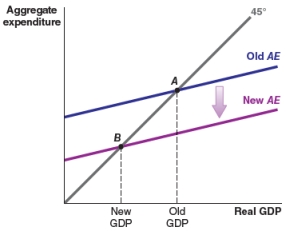
B)
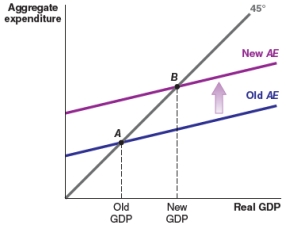
C)
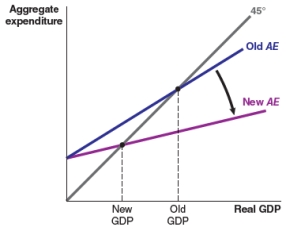
D)
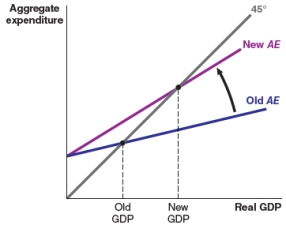
A)

B)

C)

D)


Unlock Deck
Unlock for access to all 78 flashcards in this deck.
Unlock Deck
k this deck
44
Which of the following figures shows the impact of increased tariffs on automobile imports on the aggregate expenditure function?
A)
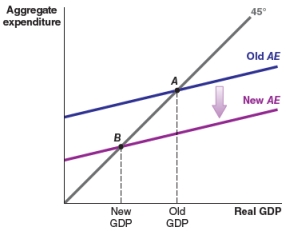
B)
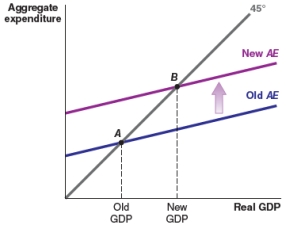
C)
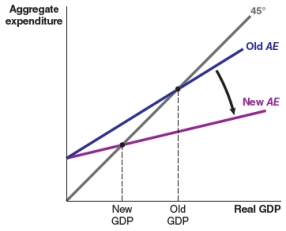
D)
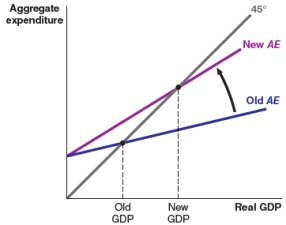
A)

B)

C)

D)


Unlock Deck
Unlock for access to all 78 flashcards in this deck.
Unlock Deck
k this deck
45
Which of the following figure shows the impact of lower interest rates on investment, on the aggregate expenditure function?
A)
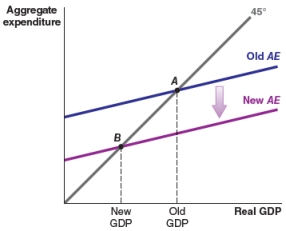
B)
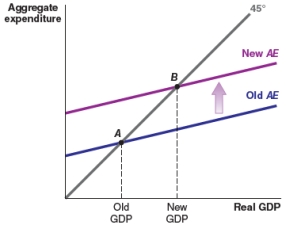
C)
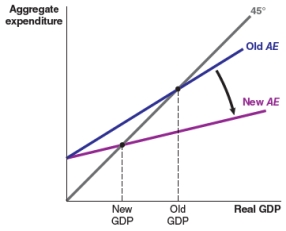
D)
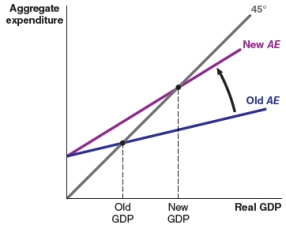
A)

B)

C)

D)


Unlock Deck
Unlock for access to all 78 flashcards in this deck.
Unlock Deck
k this deck
46
The U.S. dollar appreciates, leading to a decrease in the competitiveness of U.S. exports. Which figure shows what happens to the aggregate expenditure function?
A)
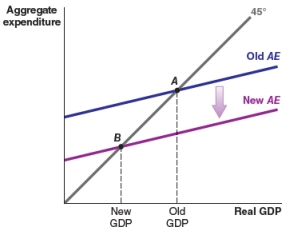
B)
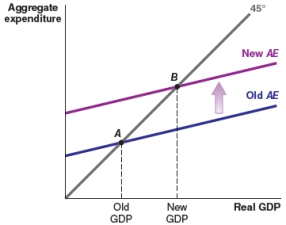
C)
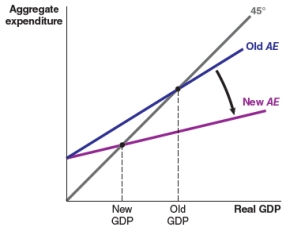
D)
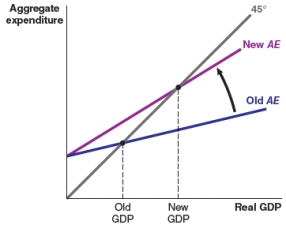
A)

B)

C)

D)


Unlock Deck
Unlock for access to all 78 flashcards in this deck.
Unlock Deck
k this deck
47
Which figure shows the impact of a rise in the marginal propensity to consume (MPC) on the aggregate expenditure function?
A)
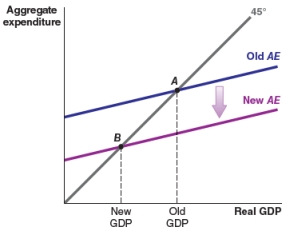
B)
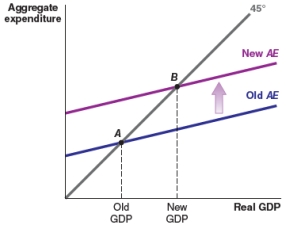
C)

D)
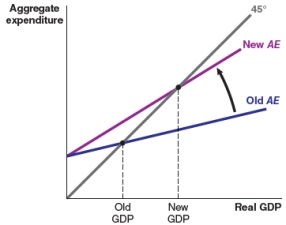
A)

B)

C)

D)


Unlock Deck
Unlock for access to all 78 flashcards in this deck.
Unlock Deck
k this deck
48
Which figure shows the impact of a fall in the marginal propensity to consume (MPC) on the aggregate expenditure function?
A)
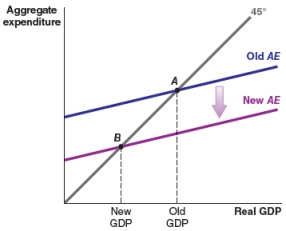
B)
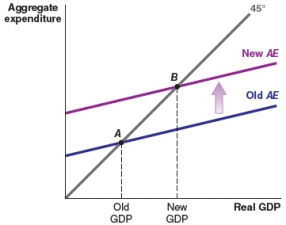
C)
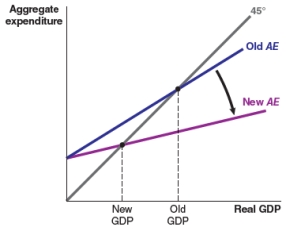
D)
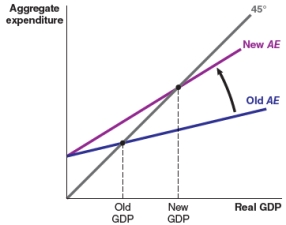
A)

B)

C)

D)


Unlock Deck
Unlock for access to all 78 flashcards in this deck.
Unlock Deck
k this deck
49
If the Federal Reserve raises interest rates:
A)consumption will not be affected, but investment will rise, and this will increase aggregate expenditure.
B)consumption and investment will increase, leading a rise in aggregate expenditure and an increase in equilibrium GDP.
C)consumption and investment will decrease, leading to a fall in aggregate expenditure and a decrease in equilibrium GDP.
D)the dollar will depreciate, and this will lead to lower imports and higher exports, and a rise in aggregate expenditure.
A)consumption will not be affected, but investment will rise, and this will increase aggregate expenditure.
B)consumption and investment will increase, leading a rise in aggregate expenditure and an increase in equilibrium GDP.
C)consumption and investment will decrease, leading to a fall in aggregate expenditure and a decrease in equilibrium GDP.
D)the dollar will depreciate, and this will lead to lower imports and higher exports, and a rise in aggregate expenditure.

Unlock Deck
Unlock for access to all 78 flashcards in this deck.
Unlock Deck
k this deck
50
If the federal government lowers government expenditure:
A)aggregate expenditure will fall, leading to a decrease in equilibrium GDP.
B)aggregate expenditure will rise, leading to a rise in equilibrium GDP.
C)consumption and investment will decrease, leading to a fall in aggregate expenditure and a decrease in equilibrium GDP.
D)the government will experience a budget surplus, which will raise aggregate expenditure.
A)aggregate expenditure will fall, leading to a decrease in equilibrium GDP.
B)aggregate expenditure will rise, leading to a rise in equilibrium GDP.
C)consumption and investment will decrease, leading to a fall in aggregate expenditure and a decrease in equilibrium GDP.
D)the government will experience a budget surplus, which will raise aggregate expenditure.

Unlock Deck
Unlock for access to all 78 flashcards in this deck.
Unlock Deck
k this deck
51
If the Federal Reserve lowers interest rates:
A)the dollar will appreciate, and this will lead to higher imports and lower exports and a fall in aggregate expenditure.
B)consumption and investment will increase, leading to a rise in aggregate expenditure and an increase in equilibrium GDP.
C)consumption and investment will decrease, leading to a fall in aggregate expenditure and a decrease in equilibrium GDP.
D)banks will lower loan amounts, and this will lead to a fall in investment, and a fall in aggregate expenditure.
A)the dollar will appreciate, and this will lead to higher imports and lower exports and a fall in aggregate expenditure.
B)consumption and investment will increase, leading to a rise in aggregate expenditure and an increase in equilibrium GDP.
C)consumption and investment will decrease, leading to a fall in aggregate expenditure and a decrease in equilibrium GDP.
D)banks will lower loan amounts, and this will lead to a fall in investment, and a fall in aggregate expenditure.

Unlock Deck
Unlock for access to all 78 flashcards in this deck.
Unlock Deck
k this deck
52
If the federal government raises government expenditure:
A)aggregate expenditure will fall, leading to a decrease in equilibrium GDP.
B)consumption and investment will increase, leading to a rise in aggregate expenditure and an increase in equilibrium GDP.
C)aggregate expenditure will rise, leading to an increase in equilibrium GDP.
D)the government will experience a budget deficit, which will lower aggregate expenditure.
A)aggregate expenditure will fall, leading to a decrease in equilibrium GDP.
B)consumption and investment will increase, leading to a rise in aggregate expenditure and an increase in equilibrium GDP.
C)aggregate expenditure will rise, leading to an increase in equilibrium GDP.
D)the government will experience a budget deficit, which will lower aggregate expenditure.

Unlock Deck
Unlock for access to all 78 flashcards in this deck.
Unlock Deck
k this deck
53
If the federal government raises taxes:
A)aggregate expenditure will fall, leading to a decrease in equilibrium GDP.
B)consumption and investment will increase, leading to a rise in aggregate expenditure and an increase in equilibrium GDP.
C)aggregate expenditure will rise, leading to an increase in equilibrium GDP.
D)the government will experience a budget surplus, which will raise aggregate expenditure.
A)aggregate expenditure will fall, leading to a decrease in equilibrium GDP.
B)consumption and investment will increase, leading to a rise in aggregate expenditure and an increase in equilibrium GDP.
C)aggregate expenditure will rise, leading to an increase in equilibrium GDP.
D)the government will experience a budget surplus, which will raise aggregate expenditure.

Unlock Deck
Unlock for access to all 78 flashcards in this deck.
Unlock Deck
k this deck
54
If the federal government lowers taxes:
A)aggregate expenditure will fall, leading to a decrease in equilibrium GDP.
B)consumption and investment will increase, leading to a rise in aggregate expenditure and an increase in equilibrium GDP.
C)the government will experience a budget deficit, which will lower aggregate expenditures.
D)aggregate expenditure will rise, leading to an increase in equilibrium GDP.
A)aggregate expenditure will fall, leading to a decrease in equilibrium GDP.
B)consumption and investment will increase, leading to a rise in aggregate expenditure and an increase in equilibrium GDP.
C)the government will experience a budget deficit, which will lower aggregate expenditures.
D)aggregate expenditure will rise, leading to an increase in equilibrium GDP.

Unlock Deck
Unlock for access to all 78 flashcards in this deck.
Unlock Deck
k this deck
55
If a country imports more than it exports:
A)net exports will increase, causing aggregate expenditure to rise and leading to an increase in equilibrium GDP.
B)net exports will decrease, causing aggregate expenditure to fall and leading to a decrease in equilibrium GDP.
C)the currency will appreciate, leading to a rise in aggregate expenditures.
D)aggregate expenditure will rise, leading to an increase in equilibrium GDP.
A)net exports will increase, causing aggregate expenditure to rise and leading to an increase in equilibrium GDP.
B)net exports will decrease, causing aggregate expenditure to fall and leading to a decrease in equilibrium GDP.
C)the currency will appreciate, leading to a rise in aggregate expenditures.
D)aggregate expenditure will rise, leading to an increase in equilibrium GDP.

Unlock Deck
Unlock for access to all 78 flashcards in this deck.
Unlock Deck
k this deck
56
If the federal government lowers taxes on investment by businesses:
A)aggregate expenditure will fall, leading to a decrease in equilibrium GDP.
B)consumption and investment will increase, leading to a rise in aggregate expenditure and an increase in equilibrium GDP.
C)imports by consumers will rise and this will cause net exports to fall.
D)aggregate expenditure will rise, leading to an increase in equilibrium GDP.
A)aggregate expenditure will fall, leading to a decrease in equilibrium GDP.
B)consumption and investment will increase, leading to a rise in aggregate expenditure and an increase in equilibrium GDP.
C)imports by consumers will rise and this will cause net exports to fall.
D)aggregate expenditure will rise, leading to an increase in equilibrium GDP.

Unlock Deck
Unlock for access to all 78 flashcards in this deck.
Unlock Deck
k this deck
57
If a country exports more than it imports:
A)net exports will increase, causing aggregate expenditure to rise and leading to an increase in equilibrium GDP.
B)net exports will decrease, causing aggregate expenditure to fall and leading to a decrease in equilibrium GDP.
C)aggregate expenditure is not affected in the long run.
D)aggregate expenditure will rise, leading to an increase in equilibrium GDP.
A)net exports will increase, causing aggregate expenditure to rise and leading to an increase in equilibrium GDP.
B)net exports will decrease, causing aggregate expenditure to fall and leading to a decrease in equilibrium GDP.
C)aggregate expenditure is not affected in the long run.
D)aggregate expenditure will rise, leading to an increase in equilibrium GDP.

Unlock Deck
Unlock for access to all 78 flashcards in this deck.
Unlock Deck
k this deck
58
Which of the following scenarios shows the multiplier at work?
A)The government estimates that GDP is expected to fall in the near future, so the government decides to increase expenditure now to boost GDP.
B)You decide to save money and begin shopping around for lower priced items. You then proceed to buy only those items that are on sale.
C)The government builds a new highway, which costs $35 billion. The construction company and the workers are paid and spend some of the money on buying goods and services from grocery stores and department stores. The grocery store employees and the department store employees then are paid and purchase more goods and services.
D)You decide to work fewer hours per week, so your income falls.
A)The government estimates that GDP is expected to fall in the near future, so the government decides to increase expenditure now to boost GDP.
B)You decide to save money and begin shopping around for lower priced items. You then proceed to buy only those items that are on sale.
C)The government builds a new highway, which costs $35 billion. The construction company and the workers are paid and spend some of the money on buying goods and services from grocery stores and department stores. The grocery store employees and the department store employees then are paid and purchase more goods and services.
D)You decide to work fewer hours per week, so your income falls.

Unlock Deck
Unlock for access to all 78 flashcards in this deck.
Unlock Deck
k this deck
59
The multiplier:
A)increases unplanned inventory stocks in the economy.
B)creates additional government expenditure expenses.
C)minimizes the impact of a change in spending on GDP.
D)causes a ripple effect of an increase in spending on GDP.
A)increases unplanned inventory stocks in the economy.
B)creates additional government expenditure expenses.
C)minimizes the impact of a change in spending on GDP.
D)causes a ripple effect of an increase in spending on GDP.

Unlock Deck
Unlock for access to all 78 flashcards in this deck.
Unlock Deck
k this deck
60
If the marginal propensity to consume is 0.5, the multiplier is:
A)1.
B)5.
C)2.
D)0.2.
A)1.
B)5.
C)2.
D)0.2.

Unlock Deck
Unlock for access to all 78 flashcards in this deck.
Unlock Deck
k this deck
61
If the marginal propensity to consume is 0.75, the multiplier is:
A)0.25.
B)4.
C)3.
D)1.33.
A)0.25.
B)4.
C)3.
D)1.33.

Unlock Deck
Unlock for access to all 78 flashcards in this deck.
Unlock Deck
k this deck
62
If the marginal propensity to consume is 0.75, how much will GDP change when the government increases spending by $25 billion?
A)$125 billion
B)$25 billion
C)$100 billion
D)$75 billion
A)$125 billion
B)$25 billion
C)$100 billion
D)$75 billion

Unlock Deck
Unlock for access to all 78 flashcards in this deck.
Unlock Deck
k this deck
63
If the marginal propensity to consume is 0.60, how much will GDP change when the government increases spending by $45 billion?
A)$75 billion
B)$60 billion
C)$45 billion
D)$112.5 billion
A)$75 billion
B)$60 billion
C)$45 billion
D)$112.5 billion

Unlock Deck
Unlock for access to all 78 flashcards in this deck.
Unlock Deck
k this deck
64
If the marginal propensity to consume is 0.8, how much will GDP change when consumption increases by $7.5 billion?
A)$37.5 billion
B)$7.5 billion
C)$15 billion
D)$6 billion
A)$37.5 billion
B)$7.5 billion
C)$15 billion
D)$6 billion

Unlock Deck
Unlock for access to all 78 flashcards in this deck.
Unlock Deck
k this deck
65
If the marginal propensity to consume is 0.9, how much will GDP change when consumption increases by $5 billion?
A)$4.5 billion
B)$5 billion
C)$6.5 billion
D)$50 billion
A)$4.5 billion
B)$5 billion
C)$6.5 billion
D)$50 billion

Unlock Deck
Unlock for access to all 78 flashcards in this deck.
Unlock Deck
k this deck
66
Which of the following is the fiscal policy reaction when a weaker GDP is expected?
A)If government policymakers expect weaker GDP, they proactively increase government expenditure to boost GDP.
B)If the Federal Reserve expects weaker GDP, it will proactively decrease interest rates to boost GDP.
C)If the Federal Reserve expects weaker GDP, it will proactively increase interest rates to boost GDP.
D)If government expenditure rises, then GDP will also rise.
A)If government policymakers expect weaker GDP, they proactively increase government expenditure to boost GDP.
B)If the Federal Reserve expects weaker GDP, it will proactively decrease interest rates to boost GDP.
C)If the Federal Reserve expects weaker GDP, it will proactively increase interest rates to boost GDP.
D)If government expenditure rises, then GDP will also rise.

Unlock Deck
Unlock for access to all 78 flashcards in this deck.
Unlock Deck
k this deck
67
Which of the following is the monetary policy reaction when a weaker GDP is expected?
A)When government policymakers expect a weaker GDP, they proactively increase government expenditure to boost GDP.
B)When the Federal Reserve expects a weaker GDP, it will proactively decrease interest rates to boost GDP.
C)When the Federal Reserve expects a weaker GDP, it will proactively increase interest rates to boost GDP.
D)When government expenditure rises, then GDP will also rise.
A)When government policymakers expect a weaker GDP, they proactively increase government expenditure to boost GDP.
B)When the Federal Reserve expects a weaker GDP, it will proactively decrease interest rates to boost GDP.
C)When the Federal Reserve expects a weaker GDP, it will proactively increase interest rates to boost GDP.
D)When government expenditure rises, then GDP will also rise.

Unlock Deck
Unlock for access to all 78 flashcards in this deck.
Unlock Deck
k this deck
68
The difference between the multiplier effect and the fiscal policy reaction is that the multiplier effect:
A)measures the effect of a change in taxes on aggregate expenditure, whereas the fiscal policy reaction measures the change in interest rates in the economy.
B)is seen only with changes in interest rates, whereas the fiscal policy reaction is seen only with changes in government expenditure.
C)links increases in government expenditure to higher future output, whereas the fiscal policy reaction links lower future output to higher government expenditure.
D)links increases in government expenditure to higher future output, whereas the fiscal policy reaction links lower future output to lower interest rates.
A)measures the effect of a change in taxes on aggregate expenditure, whereas the fiscal policy reaction measures the change in interest rates in the economy.
B)is seen only with changes in interest rates, whereas the fiscal policy reaction is seen only with changes in government expenditure.
C)links increases in government expenditure to higher future output, whereas the fiscal policy reaction links lower future output to higher government expenditure.
D)links increases in government expenditure to higher future output, whereas the fiscal policy reaction links lower future output to lower interest rates.

Unlock Deck
Unlock for access to all 78 flashcards in this deck.
Unlock Deck
k this deck
69
The difference between the multiplier effect and the monetary policy reaction is that the multiplier effect:
A)measures the effect of a change in taxes on aggregate expenditure, whereas the monetary policy reaction measures the change in interest rates in the economy.
B)measures the effect of a change in government expenditure on aggregate expenditure, whereas the monetary policy reaction measures the change in interest rates in the economy.
C)links increases in government expenditure to higher future output, whereas the fiscal policy reaction links lower future output to higher government expenditure.
D)links increases in government expenditure to higher future output, whereas the monetary policy reaction links lower future output to lower interest rates.
A)measures the effect of a change in taxes on aggregate expenditure, whereas the monetary policy reaction measures the change in interest rates in the economy.
B)measures the effect of a change in government expenditure on aggregate expenditure, whereas the monetary policy reaction measures the change in interest rates in the economy.
C)links increases in government expenditure to higher future output, whereas the fiscal policy reaction links lower future output to higher government expenditure.
D)links increases in government expenditure to higher future output, whereas the monetary policy reaction links lower future output to lower interest rates.

Unlock Deck
Unlock for access to all 78 flashcards in this deck.
Unlock Deck
k this deck
70
If total demand in the economy increases while there are supply-side constraints, the economy will experience:
A)an increase in potential GDP.
B)deflation.
C)increases in government expenditure.
D)inflation.
A)an increase in potential GDP.
B)deflation.
C)increases in government expenditure.
D)inflation.

Unlock Deck
Unlock for access to all 78 flashcards in this deck.
Unlock Deck
k this deck
71
An increase in spending in the economy will lead to an increase in production if:
A)government expenditure also increases.
B)the economy is above potential GDP.
C)there are no supply side constraints.
D)the economy has large stocks of inventory.
A)government expenditure also increases.
B)the economy is above potential GDP.
C)there are no supply side constraints.
D)the economy has large stocks of inventory.

Unlock Deck
Unlock for access to all 78 flashcards in this deck.
Unlock Deck
k this deck
72
Aggregate expenditure is made up of the following four components:
A)healthcare, infrastructure spending, defense spending, and social security spending.
B)consumption, investment, government expenditure, and net exports.
C)stocks, bonds, mutual funds, and certificates of deposit.
D)consumption, investment, government expenditure, and taxation.
A)healthcare, infrastructure spending, defense spending, and social security spending.
B)consumption, investment, government expenditure, and net exports.
C)stocks, bonds, mutual funds, and certificates of deposit.
D)consumption, investment, government expenditure, and taxation.

Unlock Deck
Unlock for access to all 78 flashcards in this deck.
Unlock Deck
k this deck
73
Consumption is $45 billion, investment is $40 billion, government expenditure is $38 billion, exports are $20 billion, and imports are $25 billion. Aggregate expenditure is:
A)$118 billion.
B)$123 billion.
C)$128 billion.
D)$143 billion.
A)$118 billion.
B)$123 billion.
C)$128 billion.
D)$143 billion.

Unlock Deck
Unlock for access to all 78 flashcards in this deck.
Unlock Deck
k this deck
74
This question has three parts.
(a) Consumption is $4.5 billion, investment is $3.9 billion, government expenditure is $4.2 billion, and net exports are $3 billion. What is aggregate expenditure?
(b) Consumption is $30 billion, investment is $27.9 billion, government expenditure is $23 billion, exports are $17 billion, and imports are $23.5 billion. What is aggregate expenditure?
(c) Consumption is $42 billion, investment is $39 billion, government expenditure is $36 billion, and the economy has a trade deficit of 25 billion. If the economy is experiencing macroeconomic equilibrium, what is the level of real GDP?
(a) Consumption is $4.5 billion, investment is $3.9 billion, government expenditure is $4.2 billion, and net exports are $3 billion. What is aggregate expenditure?
(b) Consumption is $30 billion, investment is $27.9 billion, government expenditure is $23 billion, exports are $17 billion, and imports are $23.5 billion. What is aggregate expenditure?
(c) Consumption is $42 billion, investment is $39 billion, government expenditure is $36 billion, and the economy has a trade deficit of 25 billion. If the economy is experiencing macroeconomic equilibrium, what is the level of real GDP?

Unlock Deck
Unlock for access to all 78 flashcards in this deck.
Unlock Deck
k this deck
75
Define the following concepts:
(a) marginal propensity to consume (MPC)
(b) macroeconomic equilibrium
(c) multiplier effect
(a) marginal propensity to consume (MPC)
(b) macroeconomic equilibrium
(c) multiplier effect

Unlock Deck
Unlock for access to all 78 flashcards in this deck.
Unlock Deck
k this deck
76
In each of the following cases, identify the impact on aggregate expenditure.
(a) The government raises taxes.
(b) A major trading partner country institutes tariffs on U.S. exports to that country.
(c) The government increases defense spending.
(a) The government raises taxes.
(b) A major trading partner country institutes tariffs on U.S. exports to that country.
(c) The government increases defense spending.

Unlock Deck
Unlock for access to all 78 flashcards in this deck.
Unlock Deck
k this deck
77
Consider the following data. What is the equilibrium GDP?
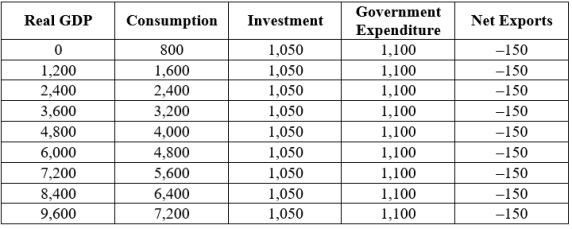


Unlock Deck
Unlock for access to all 78 flashcards in this deck.
Unlock Deck
k this deck
78
In each of the cases, use graphs of the Keynesian cross to show the impact of the change on aggregate expenditure and equilibrium GDP.
(a) The marginal propensity to consume rises.
(b) The government lowers spending.
(c) There is a fiscal policy reaction to an expectation of lower output in the future.
(d) There is a monetary policy reaction to an expectation of lower output in the future.
(a) The marginal propensity to consume rises.
(b) The government lowers spending.
(c) There is a fiscal policy reaction to an expectation of lower output in the future.
(d) There is a monetary policy reaction to an expectation of lower output in the future.

Unlock Deck
Unlock for access to all 78 flashcards in this deck.
Unlock Deck
k this deck



